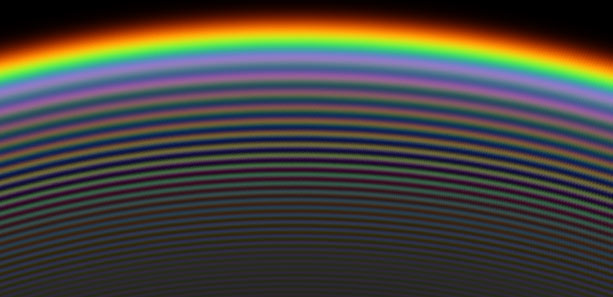
OpticsPOD
What's New
Rays & Shadows
Water Droplets
Rainbows
Not a rainbow!
Primary Bow
Secondary Bow
A's Dark Band
Other Orders
Supernumeraries
Red Bows
Rainbow Wheel
Dew Bow
Sea Spray Bow
Glass Bead Bows
Reflection Bows
Twinned Bows
Cloud Bows
Moon Bows
Image Gallery
Simulators
BowSim
AirySim
Ice Halos
High Atmosphere
Links & Resources
Search - Index
123456789012345678
| AirySim |
|
| When
a plane light wave interacts with a water drop the outgoing wave after
a single internal reflection is curved. If the shape of the wave is
somehow known then phase differences along it can be calculated and
thus the intensity of the resulting rainbow and its supernumeraries.
The English Astronomer Royal, George Biddell Airy (1801-1892), approximated
the scattered wavefront shape with a cubic form and developed an analytic
expression for the rainbow intensities in terms of what are now called
Airy integrals or functions. Airy's theory gives satisfactory predictions
of the observable features of white light rainbows(1) and is computationally
very considerably faster than the exact predictions of Mie theory.
AirySim precomputes and stores Airy functions for a whole range of arguments using an ascending series expansion(2). To compute a rainbow for a particular drop size, wavelength and refractive index(3), appropriate values of the Airy functions for each scattering angle are derived by interpolation of the stored values or, where necessary, additional direct computation. White light rainbows are obtained by repeating the calculation for closely spaced wavelengths between 380 and 700 nm and summing the intensities at each angle after weighting them by a spectral solar radiance(4). When simulations from non monodisperse droplets are required AirySim uses a droplet population function normally distributed in radius. All the above calculations have to be repeated for the different droplet radii and the intensities summed. Rainbows from the sun rather than plane parallel light are derived by convolving the angular intensities with a disk intensity function. Representation
of colours is always problematic. AirySim uses the CIE and Bruton(5)
colour models written for IRIS. |
| (1) | Lee,
R. L., "Mie theory, Airy theory, and the natural rainbow,"
Applied Optics 37, 1506-1519 (1998). http://www.usna.edu/Users/oceano/raylee/papers/RLee_papers.html |
| (2) | Abramowitz
M. & Stegun I.A., Handbook of Mathematical Functions, Dover. |
| (3) | Water
refractive indices are from IAPWS (International Association for the
Properties of Water and Steam) which are in turn based on P. Schiebener,
J. Straub, J. M. H. L. Sengers, J. S. Gallagher, "Refractive
index of water and steam as function of wavelength, temperature and
density," J. Phys. Ch. R.,19, 677-717, (1990). |
| (4) | Spectral
solar radiances were those used by Raymond Lee(1) and kindly supplied
by him in detailed tabular form. |
| (5) | Dan
Bruton of Stephen F. Austin State University, "Color Science",
http://www.physics.sfasu.edu/astro/color.html
|
